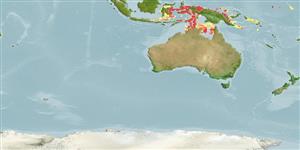Classification / Names
Common names from other countries
Main reference
Size / Weight / Age
Max length : 10.0 cm SL male/unsexed; (Ref. 48637)
Environment
Marine; reef-associated; depth range 18 - 40 m (Ref. 90102)
Climate / Range
Tropical; 23°C - 27°C (Ref. 27115), preferred ?; 0°S - 15°S
Distribution
Short description
Dorsal
spines
(total): 7;
Dorsal
soft rays
(total): 26;
Anal
spines: 1;
Anal
soft rays: 24;
Vertebrae: 26. Pale bluish in life. Chin with a median longitudinal fold. Scales tiny, closely packed, non imbricate except posteriorly on caudal peduncle. 1st dorsal higher than 2nd fin; rays of 3rd to 5th spines very long and filamentous. Pale markings on head. Named uroditaenia (Greek) in reference to the 2 dark bands on the caudal fin.
IUCN Red List Status (Ref. 115185)
Threat to humans
Harmless
Human uses
Aquarium: commercial
More information
Common namesSynonymsMetabolismPredatorsEcotoxicologyReproductionMaturitySpawningFecundityEggsEgg development
Age/SizeGrowthLength-weightLength-lengthLength-frequenciesMorphometricsMorphologyLarvaeLarval dynamicsRecruitmentAbundance
ReferencesAquacultureAquaculture profileStrainsGeneticsAllele frequenciesHeritabilityDiseasesProcessingMass conversion
Tools
Special reports
Download XML
Internet sources
Estimates of some properties based on models
Phylogenetic diversity index
PD50 = 0.5000 many relatives (e.g. carps) 0.5 - 2.0 few relatives (e.g. lungfishes)
Trophic Level
3.4 ±0.4 se; Based on size and trophs of closest relatives
Resilience
Vulnerability
Low vulnerability (10 of 100)
Price category
